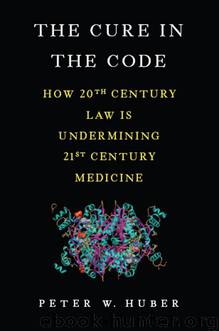Cure in the Code : How 20th Century Law Is Undermining 21st Century Medicine (9780465069811) by Huber Peter W

Author:Huber, Peter W. [Huber, Peter W.]
Language: eng
Format: mobi
ISBN: 9780465069811
Publisher: Perseus Book Group
Published: 0101-01-01T00:00:00+00:00
DRUG-RESISTANT DISEASES now kill an estimated sixty-five thousand Americans a year, more than breast and prostate cancer combined. In 2005, according to one estimate, about nineteen thousand of them—slightly more than were killed by HIV—succumbed to a methicillin-resistant staph bacterium. That we are now better at subduing nimble HIV than we are at stopping a big fat bacterium reveals much about the economics of germ-killing drugs.
With HIV, Washington inadvertently got the economic fundamentals—as viewed from Wall Street—exactly right. It failed to notice the stealthy virus during the first decade or so of its spread across America, so once drug companies grasped how widely it had spread, they had plenty of incentive to search for a cure. Quite a few patients were already in the late stages of AIDS, or soon would be, which made it relatively easy for drug companies to persuade the FDA that AZT and subsequent drugs could help. The U.S. vaccine market was also on the verge of collapse—brought to that point, as discussed shortly, with much help from Washington—so help clearly wasn’t arriving from that quarter. And no sexually transmitted disease has ever been eradicated by culture warriors or condoms. About 1.1 million Americans are now HIV positive, and about 50,000 are still infected every year. In sum, the sudden discovery of a widespread, lethal epidemic, and Washington’s persistent failure to beat it, kept one small corner of Washington’s germ-fighting bureaucracy safe and effective for Wall Street.
But not the rest. While HIV was spreading unnoticed across the country, Washington and the trial lawyers were also entrenching themselves as the final arbiters of vaccine and antibiotic science. In 1972, Congress had transferred responsibility for vaccines from the Biologics Lab to the FDA. The FDA had spent the previous decade writing new rules in the shadow of thalidomide, and safety was its paramount concern. With vaccines, which are administered to huge numbers of healthy people, that meant conducting bigger and longer front-end trials. A recently licensed vaccine—it protects against a common rotavirus that kills about sixty American children a year and hospitalizes fifty thousand—required ten years of development, followed by another sixteen years of tests involving seventy-two thousand patients.
When HIV surfaced, the FDA grew very worried about the possibility that other slow-moving, undetected viral killers might be lurking in the live animals, eggs, and cell cultures that are used to mass-produce vaccines and monoclonal antibody drugs. It was a reasonable concern, because viruses are difficult to detect. But the regulation of vaccine manufacturing grew increasingly stringent and rigid. It has ended up locking much of the manufacturing into comparatively clumsy and expensive germ-farming methods of the 1950s. Reliance on those now outdated technologies significantly slows the process and raises the cost of moving from the design of a new vaccine to mass production. Much more advanced methods are used to mass-produce the mAbs that help treat cancers and other diseases, and costs there have fallen steadily.
Meanwhile, the toxic legal spores released in the polio lawsuits of the 1950s and 1960s had mushroomed.
Download
This site does not store any files on its server. We only index and link to content provided by other sites. Please contact the content providers to delete copyright contents if any and email us, we'll remove relevant links or contents immediately.
Whiskies Galore by Ian Buxton(41718)
Introduction to Aircraft Design (Cambridge Aerospace Series) by John P. Fielding(33016)
Small Unmanned Fixed-wing Aircraft Design by Andrew J. Keane Andras Sobester James P. Scanlan & András Sóbester & James P. Scanlan(32684)
Aircraft Design of WWII: A Sketchbook by Lockheed Aircraft Corporation(32162)
Craft Beer for the Homebrewer by Michael Agnew(18081)
Turbulence by E. J. Noyes(7893)
The Complete Stick Figure Physics Tutorials by Allen Sarah(7264)
The Institute by Stephen King(6857)
Kaplan MCAT General Chemistry Review by Kaplan(6822)
The Thirst by Nesbo Jo(6758)
Bad Blood by John Carreyrou(6476)
Modelling of Convective Heat and Mass Transfer in Rotating Flows by Igor V. Shevchuk(6353)
Learning SQL by Alan Beaulieu(6158)
Weapons of Math Destruction by Cathy O'Neil(6084)
Man-made Catastrophes and Risk Information Concealment by Dmitry Chernov & Didier Sornette(5877)
Permanent Record by Edward Snowden(5681)
Digital Minimalism by Cal Newport;(5586)
Life 3.0: Being Human in the Age of Artificial Intelligence by Tegmark Max(5404)
iGen by Jean M. Twenge(5322)
